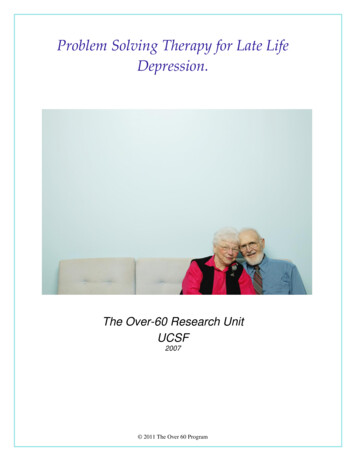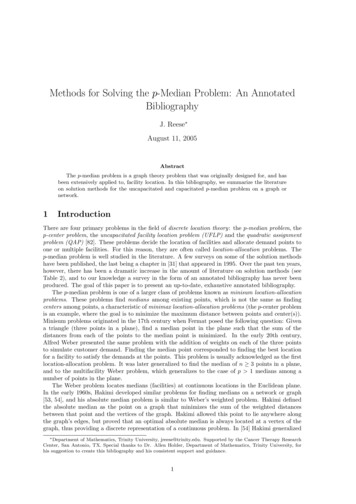
Transcription
Problem Solving Therapy for Late LifeDepression.The Over-60 Research UnitUCSF2007 2011 The Over 60 Program
Table of ContentsChapter 1: Problem Solving Overviewpage 3Chapter 2: Problem Solving Therapypage 17Chapter 4: Community Resourcespage 28Chapter 5: Special considerations when working with older peoplepage 292 2011 The Over 60 Program
Chapter 1Problem Solving Therapy for Depressed EldersProblem Solving Therapy for Older Adults is a modification of the Social ProblemSolving Therapy manual developed by Arthur Nezu and Thomas D’Zurilla and theProblem Solving Therapy Manual for Primary Care medicine, developed for theIMPACT trial. It is important for anyone using this manual to read and refer to twoexcellent books on Social Problem-Solving Therapy: Social Problem SolvingTherapy: Theory, Research and Practice (Nezu, Nezu and Perri, 1989) and ProblemSolving Therapy: A social competence approach to clinical intervention (D’Zurillaand Nezu, 1999). Over the past few years, we have made a number of modificationto PST to make it more user friendly to older adults. These modifications wereinformed by our experience in using PST, as well as from feedback from our pastclients.The first modification is that the examples given to illustrate the problem-solvingstages have been modified to focus primarily on issues specific to late life. Ourexperience has shown that a mix of geriatric and depression specific problems makesthe intervention more acceptable to older people. The second modification has beenthe length of treatment. We have found that older adults tend to need more time toabsorb the information and more time to practice the stages of problem solving thanyounger patients. This version of PST is 12 sessions long. The last modificationincludes the use of strategies for those with mild cognitive impairments. Thesemodification are discussed in more detail in chapter 4.PST-OA can be done individually or in a group setting. In order for PST-OA to beeffective, one must make sure the patient (1) understands the rationale behind themodel and (2) understands it’s application. Educating and socializing the patient totherapy is often important with older people. Some have never been in therapybefore, and therefore an explanation of how the treatment will work, how often youwill meet, the importance of homework and so forth will be very important to detailin the first session. A good geriatric therapist always asks patients what theirexpectations are of therapy, and tries to allay any concerns or misconceptions. Some3 2011 The Over 60 Program
older people have had psychotherapy in the past, but most likely will not have beenexposed to a structured therapy like PST-OA. It is important, in this case, that thepatient understand the difference between PST-OA and traditional psychotherapy.Telling the patient that they will be learning a new set of skills rather than relyingexclusively on discussion of problems is a key difference between PST-OA andtraditional therapies.PST consists of seven stages that efficiently address psychosocial problems.These stages are (1) selecting and defining the problem, (2) establishing realistic andachievable goals (3) generating alternative solutions (4) implementing decisionmaking guidelines, (5) evaluating and choosing solutions (6), implementing thepreferred solution and (7) evaluating the outcome. The unique feature of PST overother psychotherapies is its fit with the case management process. Therapists canuse these stages in creating a link between their clients and social programs, and indoing so, demonstrate the PST process to their clients with the intent of clients usingthe process to solve non-case management problems. Thus, therapists and clientswork together, using the same logic model to solve both social and psychologicalproblems.This manual describes how to teach problem solving skills to older adults withMDD. The manual is the result of 15 years of research at UCSF on theimplementation of PST to older adults with medical illnesses and mild cognitiveimpairments in several ethnic groups and socio-economic settings.Chapter 2 of the manual describes the problem solving process. In chapter 3 weprovide general information regarding of aging resources and organizations shouldhelp in developing action plans for clients with socio-economic need. In chapter 4,we discuss issues related to working with older adults, including the impact ofageism on motivation for change and how disability affects treatment. Alsoincluded are the PST form and the Problem List, described in Chapter 2.4 2011 The Over 60 Program
Chapter 2Problem Solving TherapyThis chapter describes the specific stages of PST and how to use the PST formto solve both case management and client problems. This chapter will go throughthe step-by-step of how to use PST with patients, from initial session to relapseprevention.The Therapeutic Frame:Time Frame: PST is a brief treatment, it can be as brief as 4 sessions and as long as 12.How long you offer PST will be determined by patient recovery, clinic mandate orstudy design. In our research, we have found that the smallest effective dose of PSTis 4 sessions, offered over an 8-week period of time. The most ideal number is 6sessions, this is when we tend to see the biggest difference in treatment outcomeswhen PST is compared to other psychotherapies, but we believe that 9 sessions bethe PST sweet spot for most patients. Each session is on average 40 minutes long, butplan for 45 in usual mental health care and 30 in primary care medicine.Setting: PST is effective in a variety of settings and presentations. There is evidencethat PST is an effective telephone therapy, primary care intervention, home-basedtreatment and finally as an internet intervention. We are in the process ofdetermining PST's effect as a mobile health app.Format: PST is divided into three phases: Introduction/Education, Training, andPrevention phases. The first 1-2 PST sessions is spent getting to know the patient, theproblems they are experiencing, how their symptoms interfere with daily activities,and if they need remedial problem orientation work. Additionally, patients becomefamiliar with the PST process and socialized to the therapy. The middle sessions arespent encouraging the use of the PST skills. The last session or two is spent helpingpatients develop a relapse prevention plan based on the PST format.Structure: To be effective, brief treatments need structure, but you don’t have to loseyour therapeutic style or act like a robot when you do PST. You can use your clinicaljudgment, just don’t go off the rails. The typical sessions structure looks like this:1. Setting the Agenda2. Review progress (PHQ-9, Action Plans, Pleasant Activities)3. Selecting a problem and solving it5 2011 The Over 60 Program
4. Reviewing the action plan and activities5. Session wrap up.Introductory PST Stages: Education, Activation and Problem Orientation.Educate and activate your patient; OR How to establish a working alliance in abrief period of time.Like all therapies, for PST to be effective, patients have to understand the treatmentand buy into the therapeutic rationale. This is done through brief education of boththe therapeutic frame (how you will work together) and the therapeutic rationale(why we use this model). You do not need to spend much time, on this just enoughto explain to the patient how PST works, and to answer any questions or concernsthey may have about treatment. The basic things you want to cover in youreducation of PST is:Introducing PST Check List1. Explain treatment structure Number of sessions Length of visits How often will meet Structure of meetingo Start with agendao Review PHQ-9o 15 minutes problem solvingo End each session with an action plan Importance of PHQ-9 Using a worksheet initially to solve problems Work is collaborative2. Explain PS theory of depression Everyone has problems We may become depressed when have too many problems or facedwith problems we do not know how to handle6 2011 The Over 60 Program
When we become depressed, we withdraw and don’t feel like doinganything This makes us feel hopeless and helpless The less we do, the worse we feel – it’s a cycle, but we can break it With PST, we will be targeting one problem at a time, because themore we do, the better we feel.3. Explained PST processoPST is seven stepsoStarts with a brief problem listoThen we pick one problemoDefine it, which means getting details about the problemoWe set a goaloCome up with a list of ways to meet that goaloTalk about the list of options and evaluate them based on whatis most feasible for you to dooWe create a step-by-step planoYou do the plan and we talk about it at the next sessionoYou will also solve other problems on your own betweensessionsoDon’t worry if a plan doesn’t work perfectly, that’s all part of learning more about the problem, and helps us come up with abetter idea of what is going on.4. Explanation Process Check in with patient about understanding after each section Ask patient if have any questions Use easy to understand language Be empathic Stance is collaborative, not didactic7 2011 The Over 60 Program
Setting the problem List:The next step to prepare for PST is to make a list of the problems patients feel arecontributing to or suffering from their depression. In this phase, keep the list simpleand structure the discussion around these common areas: Problems with friends,family, finances, work, school, chores, health, the law, and housing. Use the ProblemList in the appendix to guide this discussion.Problem Orientation (Optional):For some patients, the very idea that their problems have solutions is beyondcomprehension. When asked to think about their problems, some patients becomeemotionally overwhelmed and have difficulty focusing on the details of theirproblem , others are so hopeless and pessimistic that they simply do not believe theirproblems can be solved or they believe there are solutions but the outcome is "notgood enough". Although emotion management, negativity and hopelessness arecommon features of depression, people experience these symptoms in varyingdegrees. We have found that most people suffering from depression can controltheir emotions and pessimism enough that they can start the seven-step PST processright away and do not need extra help orienting their thinking to actively solveproblems. Others however are disabled by their negative thinking and emotions,and will need a little extra help orienting their thoughts toward solving problems.For this reason, we have included, in the initial stages of PST, a focus on managingemotions and negative thinking (called Problem Orientation in the Nezu PST model)but have made it an optional step in the process for patients who are able to startsolving problems and are more hopeful about the outcome.The purposes of problem orientation are to make patients aware of theirparticular problems with daily living, to minimize the emotional content of theproblems they face, and to increase their motivation in problem solving. Theprocess of orientation consists of five distinct variables: problem perception,problem attribution, problem appraisal, personal control beliefs, andapproach/avoidance style (Nezu, Nezu, Perri, 1989). In problem perception, thepatient must identify a problem, and the context in which it is faced. Though theproblem might bring up emotions for the patient, it is essential that they try to putthe emotional baggage aside so they can attend to the problem in a strategic,methodical fashion. With problem attribution, the patient, with the aid of thetherapist, must try to achieve a realistic perspective of the cause of the problem.They might have an overly negativistic perspective and consequently attribute anunrealistic percentage of the blame on internal factors. Conversely, patients mighthave an attributional style that gives too much credence to external factors thatmight also be unrealistic. The patient must, then, attempt to find the realistic8 2011 The Over 60 Program
balance in order to disentangle the problem in a pragmatic fashion. In problemappraisal, the patient evaluates the problem in its significance and value to theirpersonal well-being. The personal control variable is also important to address fromthe outset because patients must learn that they cannot change the behavior ofothers or many external circumstances. Instead, they have the opportunity to alterthe way they react to the situations they cannot control, and to cope effectively withinevitable stressors. Additionally, the attitude with which the patient chooses toaddress the problem can make a difference. They must be proactive, rather thanavoidant. They must not avoid issues that arise, but rather systematically addressthem. This issue might be particularly difficult for the patient with ExecutiveDysfunction to accomplish. The therapist must then make a concerted effort toencourage the patient to be motivated. Once these tasks have been accomplished,the patient and therapist will be ready to move on to the seven problem solvingsteps.Problem Orientation Strategies.Emotion management: Strategies for emotion management can be anything that helpscalm emotions and redirect attention away from negative feelings to a relaxationstate. Typical emotion management strategies are:Emotion management strategiesMeditationRelaxation Exercises Deep BreathingPrayerImagerySelection of an appropriate strategy for a given patient should follow after weighingpros and cons in a problem solving format based on previously helpful experiencesto the patient. The selected strategy is meant to be practiced by patients over time sothat when they begin to feel overwhelmed by emotion, they can use these techniqueseasily. With all these strategies, patients will need a quiet place to practice for about10 minutes a day. Patients record their mood before practice and after practice. Theyare also instructed to incorporate the strategies before each step of the action plan.Negativity Bias: Strategies for coping with negative focus help the patient evaluatetheir situation in a balanced way by teaching patients to recognize when they areover attending to negative environmental cues and how to draw attention to neutralor positive aspects of the situation. In PST, we use modified Cognitive BehavioralStrategies (CB) to overcome this barrier. Rather than applying CB strategies for allsituations, however, we ask patients to use the strategies specifically when they9 2011 The Over 60 Program
encounter trouble implementing their action plans. If the patient decides to use thestrategies for other situations, that terrific; but it is not necessary.The negative focus strategies are:Negative focus strategiesDevil’s AdvocateWeighing the evidencePractice seeing positivity biasDevil’s Advocate: The devil’s advocate technique is one way to help patientscounteract their negative thinking. All this involves is a few steps:1. Write down the reasons why you would not do the action plan;2. Take the opposite view from the negative reasons: what would you say to getsomeone else who is making the same argument you are making to do theaction plan.3. Organize the positive arguments and refer to them whenever you want toabandon the action plan.Weighing the Evidence: This is a relatively easy exercise that can enhance motivationto engage in action plans and overcome negativity biases. Using the Weighing theEvidence worksheet in the appendix, all you ask the patient to do is:1. Estimate the patient’s predicted probability that worst expectations will cometrue;2. Ask the patient to think back to all the times they engaged in a similar actionplan or activity and have them state how often the patient actuallyexperienced the expected negative outcome, the estimate if that was less andabout or more than half the time;3. The patient’s assignment is to engage in the action plan and then document ifthe negative outcome actually occurred. Talk to the patient about thedifference between their assumed, predicted and actually experience that thenegative event happened.Practice using a positive focus: Having a positive focus is the brain’s tendency to seek10 2011 The Over 60 Program
out and pay particular attention to pleasurable and positive environmental cues.Like negative focus, this is a natural brain function. When people are depressed, apositive focus is muted, and patients will need to work hard to strengthen thiscognitive process to overcome their depression. Patients who chose to control theirnegative focus by engaging a positive focus will need to practice using the strategiesbelow until they feel comfortable (some patients claim it never feels natural, amajority claim they are helpful). Patients can chose to use one or all of the followingtools to help them implement their action plans Think outside yourself. Ask yourself if you’d try to talk other people out of asimilar action plan. If you wouldn’t, stop being so hard on yourself. Thinkabout less negative statements that offer more realistic expectations about theaction plan’s success. Keep a “negative thought log”. Whenever you experience a negative thoughtwhen implementing an action plan, jot down the thought in a notebook.Review your log when you’re in a good mood. Consider if the negativity wastruly warranted. For a second opinion, you can also ask a friend or therapistto go over your log with you. Changing perspectives. Review your negative thought log. Then, for eachnegative thought, write down something positive or find an alternativeexplanation. For instance, “My boss hates me. He gave me this impossibletask to do.” could be replaced with, “My boss must have a lot of faith in me togive me so much responsibility,”, “My boss has given me so much workbecause this is an important project with an impending deadline” or “Otherpeople have been given similar assignments.” Socialize with positive people. Notice how people who always look on thebright side deal with challenges, even minor ones, like not being able to find aparking space. Then consider how you would react in the same situation.Even if you have to pretend, try to adopt their optimism and persistencewhen implementing your plan.REMEMBER: THESE STRATEGIES ARE OPTIONAL. IT'S BETWEEN YOU ANDYOUR PATIENT TO DECIDE IF THIS WOULD BE HELPFUL.11 2011 The Over 60 Program
The Seven Stages of PST TreatmentIt is important to review the stages involved in PST. They are1. Selecting and defining the problem5. Evaluating and choosing solutions2. Establish realistic and achievable goalssolution6. Implementing the preferred3. Generating alternative solutions7. Evaluating the outcome4. Implementing decision making guidelines8. Activity SchedulingEach stage of PST is represented on the PST form (appendix A). This formwas created with older adults in mind, with large font to account for visionproblems, and big writing spaces to account for graphomotor impairments. Below,we discuss each stage of PST, and how to complete the form.Stage 1: Selecting and Defining the ProblemThe goal for this stage is to succinctly define the selected problem. We feel itis important to note that for case management problems the most pressing andurgent problems should be selected first, working down the list to the least pressingproblems. Clients tend to be too distracted by urgent problems to learn PST. Byprogressing through problem selection in this manner, clients will be ready to learnthe PST process.Selection of client problems, however, should progress in the opposite order.Selecting these less complex problems early on in PST facilitates clientunderstanding of the model, and gives clients the opportunity to achieve successwith the model in relatively short order. In our experience, focusing on a verysensitive problem can distract the client from the learning process.Most clients will describe their problems in vague and unclear terms. It is notuncommon to hear clients say that their problem is “procrastination”, “being poor”or “being sick”. While the essence of these terms may be true, the details are12 2011 The Over 60 Program
missing. What does it mean to procrastinate? Is the client complaining aboutpaying rent in a timely fashion or attending to a health plan the physician created?How is “being poor” problem for the client? Is the client having trouble paying billsor can the client pay bills but is unable to purchase gifts for friends? As can be seen,these general terms do not help in determining how to solve the problem.Defining problems involves the following: Discussing the specifics of the problem Breaking large problems down into small steps Using concrete and observable terms to describe the problemDiscussing specifics of the problem. It is practically impossible to solve anyproblem without a thorough understanding of the problem to be addressed. If theproblem is not thoroughly explored prior to developing solutions then the therapistand client run the risk of generating inadequate, and even worse, irrelevantsolutions. For clients, this means having them describe in detail the factors thatmake their situation problematic. Getting information about the unmet needs, whythey have not been addressed and all the barriers and obstacles encountered byclients is important before therapists and clients embark on developing an actionplan.Breaking down large problems into smaller and more manageable parts. Problemsare often comprised of a number of smaller, yet distinct, interrelated parts. Failureto differentiate these components leads to an overly vague problem definition that inturn leads to an inefficient action plan. Being poor is a large problem, with manypotential issues. One client had complained that being poor affected her ability toseveral things, such as pay her rent on time, purchase medication, buy new clothing,and purchase gifts for her grandchildren. Each of these areas is a problem in its ownright, deserving of its own, separate action plan. Further, as can be seen in thisexample, some problems are case management problems and others are clientproblems. Therapists can enact a plan to pay for medication, but only clients canenact a plan to buy gifts for family.State the problem in a clear and objective form. Once the problem has beenbroken down into smaller parts, and all aspects of the need or problem have beendiscussed, clients and therapists can now define the problem or need succinctly. It isimportant to describe the problem or need into observable terms, such that clientsand therapists will know definitively when the problem or need has been met.Examples of defined problems versus undefined problems are:13 2011 The Over 60 Program
UndefinedDefined“Poverty”“I cannot pay my electricity bill”“Paralysis”“I can’t get my mail from the mailbox”“Procrastination”“I forget to use my walker everyday”Sometimes clients will identify neurovegetative symptoms of theirdepression, such as problems with energy, sleep, or motivation, as problems.Although these symptoms are “problematic” they are not objective life problemsand therefore are not the best problems to identify for problem solving.Nonetheless, if the client insists that they wish to address these, or there are noobjective life problems that appear to exist, then a symptom may be chosen as theproblem area as long as the functional correlates of the symptom are identified. Theproblem definition is then constructed in reference to the functional impairmentrather than the symptom. For example, low energy may have the function ofdecreasing the client’s ability to do housework, and in which case the problemdefinition becomes “trouble getting housework done”. Likewise, lack of motivationmay interfere with going out of the house to visit with friends, and the problemdefinition becomes “difficulty doing self care activities.” As clients become moreeffective in resolving these functional problems their depression will begin to lift andthe symptoms of low energy and motivation will improve.Once the problem has been succinctly defined, write it down on line one ofthe PST form.Stage 2: Establishing Realistic and Achievable Goals for Problem ResolutionOnce the need or problem is defined, the next step is determining what clientswould like to see changed. This goal should be as clearly and succinctly defined asthe problem or need is. The goal should also be achievable with a reasonableamount of effort and time. Therefore, it is important to take into account the balancebetween the available resources and the time frame for its achievement. Clients andtherapists will have long-term goals that they intend to reach by the end of the 12weeks. These long-term goals can usually be broken down into steps that can beaccomplished from meeting to meeting. For instance, one client had a long-term14 2011 The Over 60 Program
goal of paying off his debts. This goal was further divided into setting a budget,paying off his utility bills first (before winter), then his credit card bills and finallyhis medical bills. These were further divided into smaller, achievable steps, such asfinding out which financial programs he was eligible for. By breaking the goals intosmaller goals that could be reached each week, the client felt a sense of success, moreso than if his only goals was to relive his debts.Setting clear behavioral goals is important during Stage 7 when the success ofthe solution implementation is evaluated. When the set goal stipulates a specificoutcome (e.g. getting transportation, calling one’s family) and those outcomes occur,then it is clear that the problem-solving plan worked. Once the goal has beendefined, this is recorded on line 2 of the PST form.Stage 3: Generating Multiple Solution Alternatives: BrainstormingOnce the goal has been set, you are now ready to generate a range of potentialsolutions. Research has shown that depressed people often have a very difficulttime generating solutions, partly because they are discounting the effectiveness ofsolutions before adequately defining them. Teaching individuals to creatively thinkof a range of possible solutions is based on the premise that the availability of anumber of alternative actions will increase the chances of eventually identifyingparticularly effective solutions. In other words, the "first idea" that comes to mind isnot always the "best idea". Therefore, it should be emphasized to the client that theyshould try to generate as many solutions as possible via "brainstorming" techniques.Successful brainstorming involves: Listing at least five solutions Solutions must address the goal Clients and therapists must withhold judgment For client problems, the solutions must come from the client, not therapistList at least five solutions. The quantity of solutions generated is important. Thegreater the numbers of potential solutions, the greater are the chances for successfulresolution of the problem or need. Having a large number of solutions also allowsclients and therapists to combine ideas when practical to do so.15 2011 The Over 60 Program
Therapists using this approach may find it difficult to generate more than one ortwo obvious solutions for a particular need. For instance, if a client needs to get tomedical appointments and is not linked to Para transit, the obvious solution for thetherapist is to link the client to that service. However, for the benefit of the client, itis worth while to consider other options so that the client can observe that there isusually more than one way to solve a problem, and the client can observe thetherapist employ the decision making strategies described later.Solutions must address the goal. At times, clients tend to list whatever ideacomes to their mind without considering the relevance to the problem. This is arelatively rare occurrence, but does happen. If, when generating solutions, clientsbegin to list what appear to be irrelevant solutions, therapists should ask how thesolution is related to the goal, even before the brainstorming process ends.Sometimes clients list seemingly irrelevant solutions because there is another aspectto the problem that was not discussed. In this case, problems should be redefinedand goals newly specified.Withhold judgment until the next stage. Do not judge the ideas until thebrainstorming process is completed, otherwise a potentially successful and novelsolution may be prematurely abandon. Evaluation of the feasibility of each option isleft for the subsequent stage (Stage 4: Implementing Decision-Making Guidelines:Pros and Cons).The solutions should be listed in the grid on item 3 of the PST form.Stage 4: Implementing Decision-Making Guidelines: Pros versus ConsThe purpose of stage 4 is to strategically evaluate the alternative solutions byimplementing decision-making guidelines. Therapists and clients create a list of the“pros” and “cons” for each potential solution. This involves asking the followingquestions: Does the solution meet long term and short goals What is the impact the solution will have on the client, other people and/ orsociety.16 2011 The Over 60 Program
Is the solution feasibleDoes the solution meet long term and short term goals? The main point of thisquestion is to determine the feasibility of therapists and clients being able toimplement the solution between meetings. Some solutions may be excellent ataddressing a need in the long run, but if selected, should probably be combined withanother solution that can meet a short-term goal so that clients experience somesuccess from week to week.What is the impact the solution has on the client, other people, and/or society? Themain point in asking this question is to determine if the solution will create someother, unforeseen problem. For instance, relying on family for transportation maymeet a goal of going to wee
Problem Solving Therapy for Older Adults is a modification of the Social Problem Solving Therapy manual developed by Arthur Nezu and Thomas D’Zurilla and the Problem Solving Therapy Manual for Primary Care medicine, developed for the IMPACT trial. It is import










